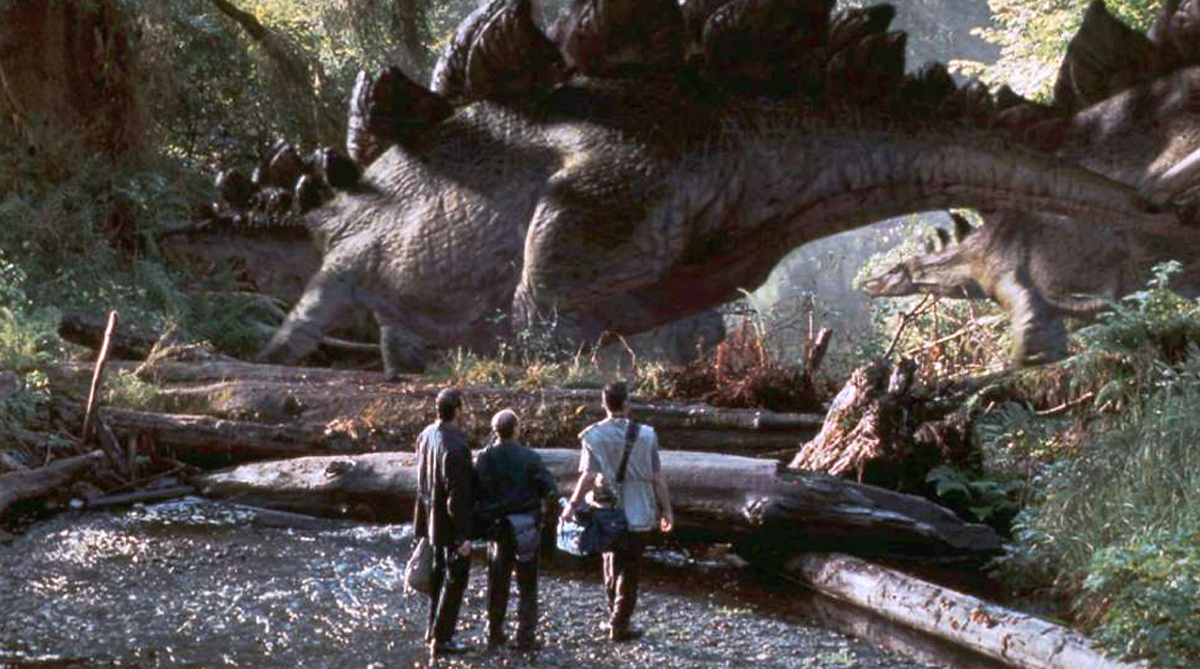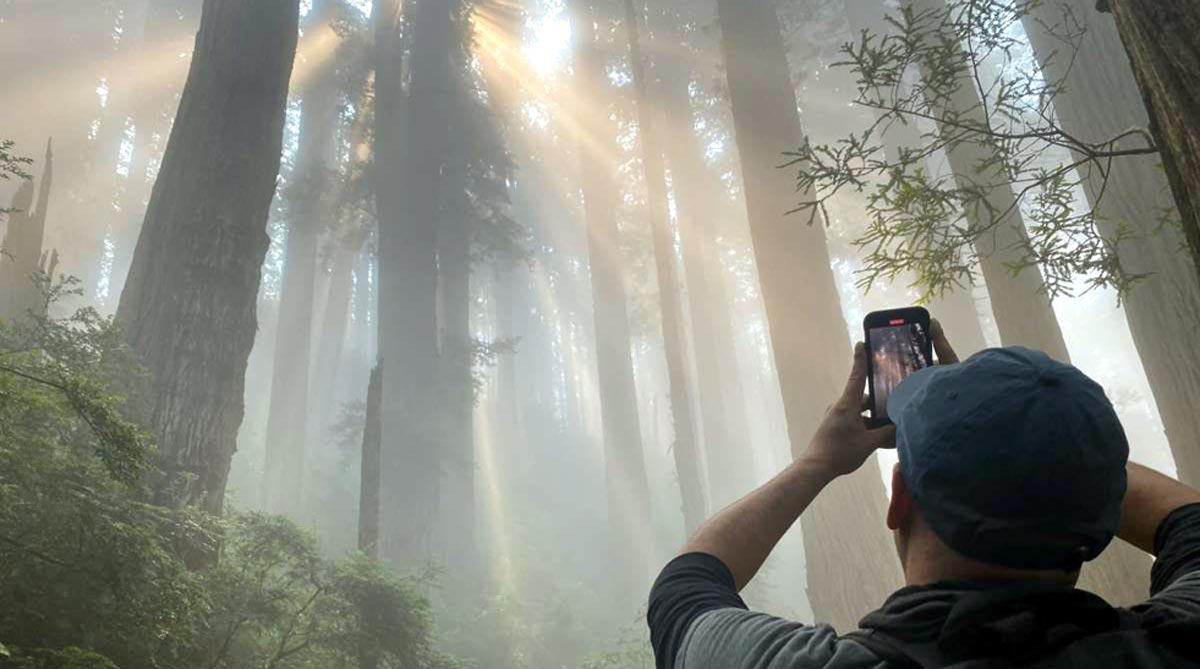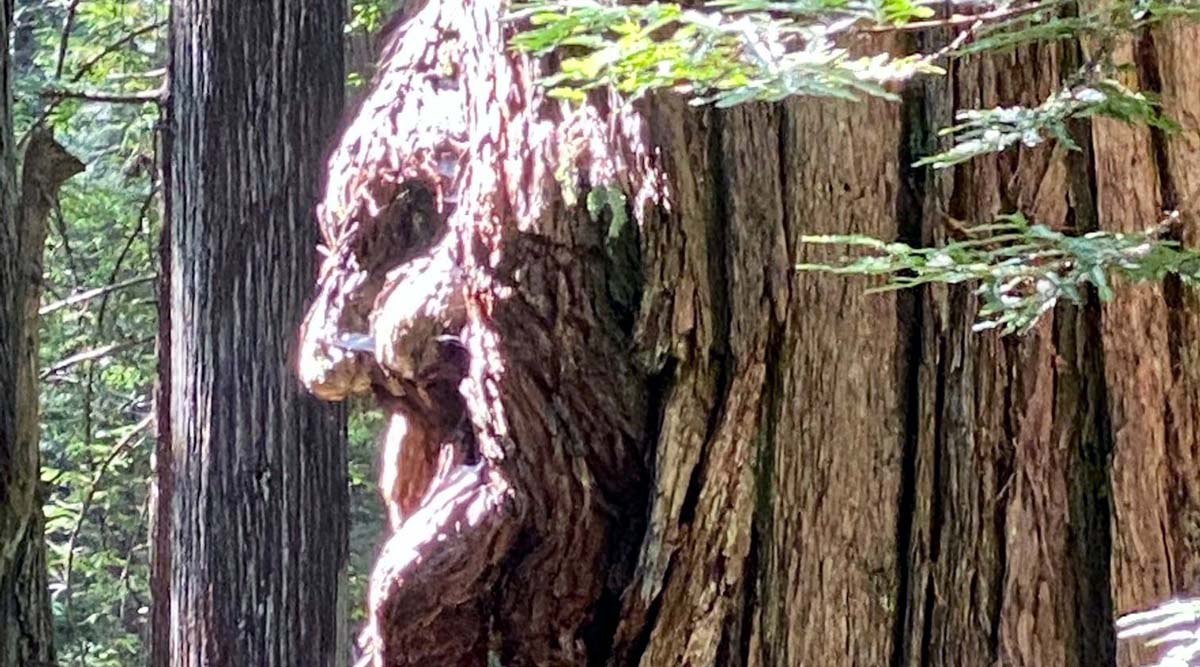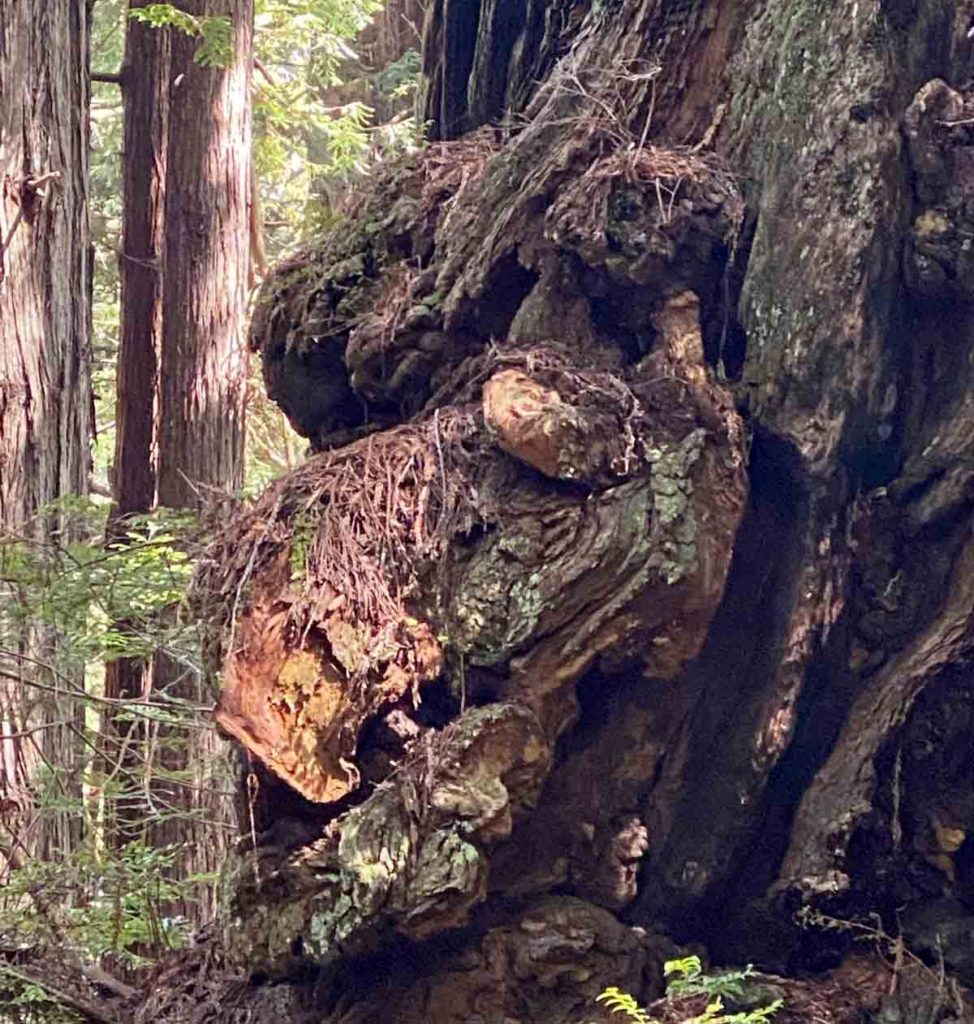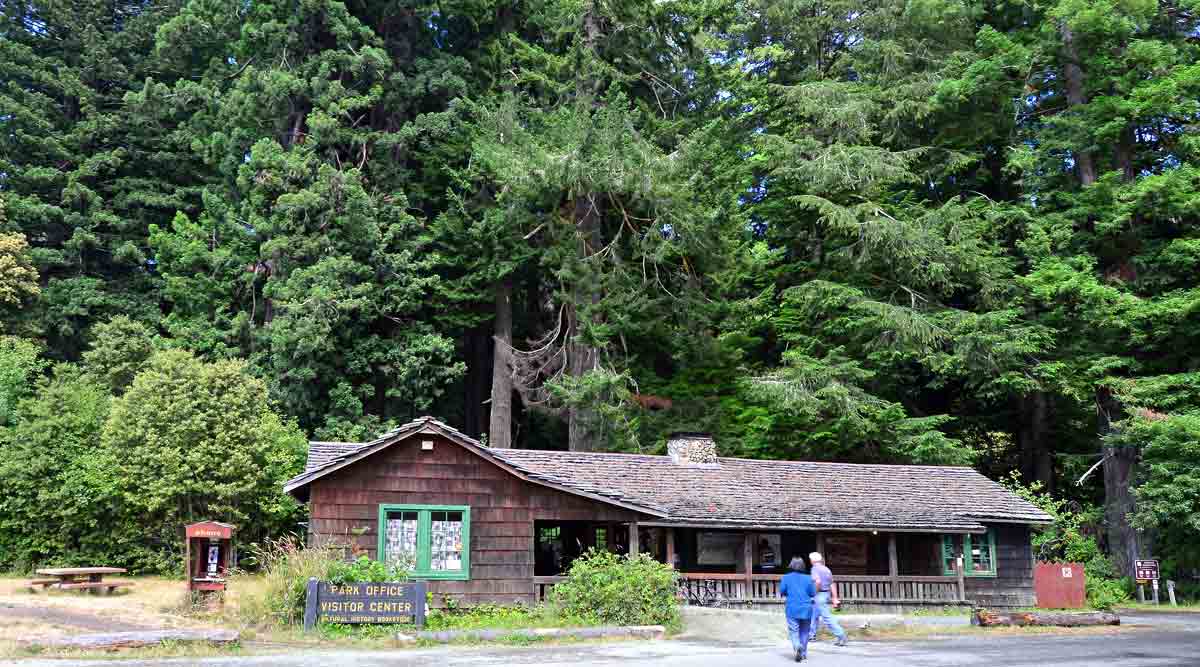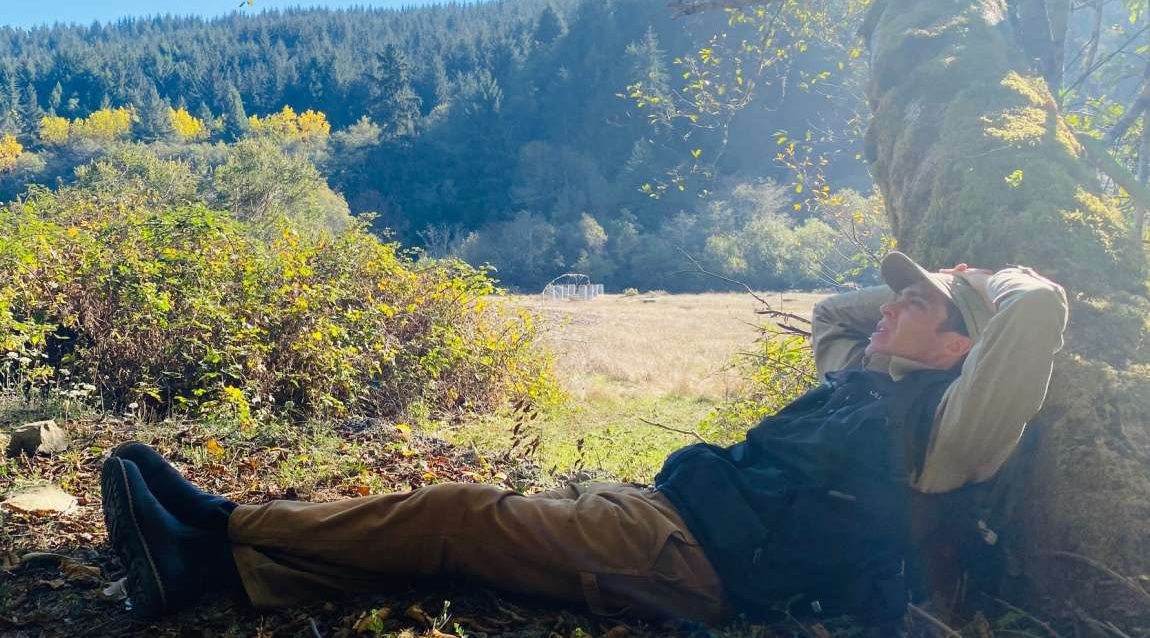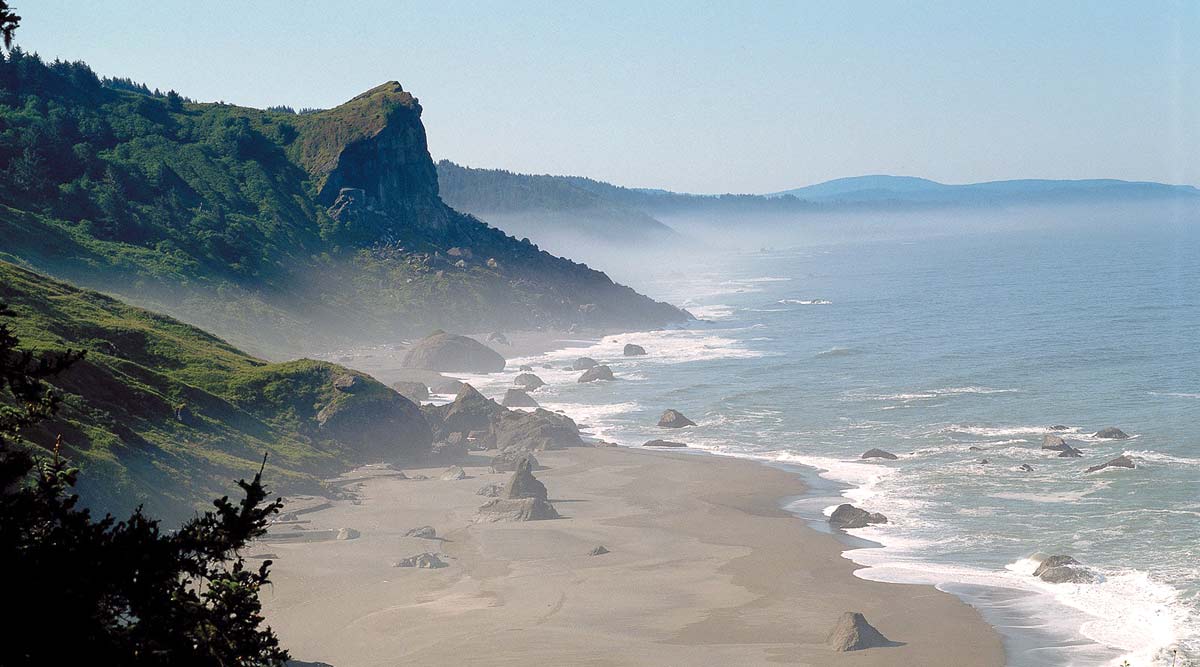Ashley Harrell/SFGate.com
When naturalist Justin Legge was a young boy growing up in Ashland, Ore., there was an oak tree in his front yard that he used to climb. Even now, at 32, he can remember exactly the way the ants smelled when he squished them against the tree.
“Do you have a memory in your brain about a tree, from when you were young?” asks Legge.
There was a time I took my shirt off, climbed into a tree with a bunch of boys and got all scraped up, but that feels weird to mention, so instead, I say I have forgotten most of childhood, which is also true.
We’re walking from Elk Meadow Cabins, where Legge works as the manager of the lodgings and attached Redwood Adventures tour business, through a clearing and toward a creek and forestland on the outskirts of Redwood National and State Parks. It’s Legge’s standard introduction, an attempt to call to mind our visceral childhood memories involving trees. He uses it every time he guides forest bathing.
For the uninitiated, forest bathing — or shinrin-yoku, as its Japanese creators call it — is a process of taking in the forest through the senses. Breathing it. Smelling it. Feeling it. Watching it. The practice got started in the 1980s as a way to combat high rates of suicide among Japan’s working class; today, spending time on certified “therapy trails” is considered medical treatment, and scientists are studying it around the world.
I had read that forest bathing had certain health benefits, like boosting immunity, reducing anxiety and lowering blood pressure, but wasn’t sure how reliable that was. Susan Abookire, a doctor who works as an assistant professor for Harvard Medical School (and also guides forest bathing) admits that more data is needed. “It’s all fairly small studies and a lot of them did not happen in the United States,” says Abookire. But a key benefit, she says, is breathing in phytoncides, which stimulate the production of certain white blood cells that fight tumors and viruses.
Abookire is careful not to oversell the science at this point, and really it’s just something you have to experience, she says. That’s part of why she’s designed two new curriculums for internal medicine residents that incorporate forest therapy.
Under normal circumstances, if somebody told me they could guide me in breathing near trees, it would set off my bullshit detector. In booking an $85 forest therapy session for the day before the election, though, I was hoping to distract myself with something out of the ordinary, something benign.
“Your main focus is to achieve nothing and to think about nothing, and to clear your mind and focus on what’s around you,” Legge explains. And actually that’s harder than most people realize.
On a usual hike, a human spends a lot of time thinking about things like: “What time is it? How far do I have to go? Where’s my water bottle? Is that a tick?” Legge says. “There are so many things that our monkey minds are over-analyzing and freaking out about all the time.”
So that’s basically why you need a guide, he says, which actually surprised him, too, back when he first got into this. Legge studied outdoor recreation in college and has worked for the Forest Service in Lake Tahoe, in addition to holding jobs as an educator and a guide and facilitating groups. He’s an emergency medical technician and a wilderness first responder.
“Why do I need a piece of paper that says I’m a forest therapy guide?” he wondered before going through the training with the Association of Nature and Forest Therapy. “I was the person saying, ‘You don’t need that! Who cares! Whatever!’”
Against his better judgment, Legge attended the training, a seven-day trip into the Eastern Sierras last October. He says he emerged with a new set of new forest friends and a brand new body of knowledge, and became the first and only certified forest bathing guide in Humboldt County.
“This is a standardized method that flips specific psychological switches; it basically always works,” Legge says. “The goal of a forest therapy program is to exit our normal consciousness … to exit the human world.”
Legge is quirky and dramatic, but he’s also incredibly knowledgeable about Redwood National and State Parks. He cares deeply about providing visitors with an experience that is as fun as it is educational. If I were going to try this unusual practice, I was pleased to have someone a bit eccentric to guide me through.
When we reach the forested area, Legge has us sit comfortably on mats, anywhere we want as long as we can hear him, and close our eyes. He offers a reminder that he is not a therapist. “I am a guide. The forest is a therapist,” he says. “I would like to introduce you to this amazing therapist. She knows some pretty good stuff.”
Read More
He gives us a series of invitations, which we are welcome to accept or ignore. There are no requirements, no correct answers, no prizes, no wrong way to do this.
“I’ll invite you to just take some deep breaths. In through your nose,” he says. “Just normal breaths, noticing what the sensation of breathing feels like.”
He speaks slowly, deliberately.
“Noticing right now, you are sitting,” he says. “Wonder what it feels like to be sitting.”
Suddenly, the wind picks up and blows a few strands of hair onto my face. I can hear the traffic of the nearby highway, which, according to Legge, is ideal. Forest bathing doesn’t happen in deep wilderness, he says. The Japanese designed the practice to take place at the edge of the forest, the satoyama, as they call it.
This is a way to begin seeing the human world as part of nature, rather than something separate. It also makes forest bathing accessible to anyone who can find a tree, or even an ocean, which apparently also works.
Legge asks us to shift our weight from side to side. To notice the sensation of our bare skin, feeling the air, feeling the wind. To touch the Earth. To rub dirt on a finger and smell it. “I wonder where the smell might take you.”
I haven’t exactly been taken anywhere, but I do notice that I’m starting to relax. To slow down. After a few more invitations, Legge has us stand, facing any direction we like. He asks us to report what we are noticing, just in a few words.
“The pull of the sun, and its warmth,” I find myself saying.
The next invitation — which can sometimes feel uncomfortable, Legge warns — is to simply walk slowly and notice “what’s in motion.” We’re allowed to go off-trail or wherever we want. There are no right or wrong answers. Legge will hoot like an owl to indicate that we should meet him back in the original spot.
I start to amble along the path, taking note of how the strands of spider webs twitch with the breeze. Bugs and translucent fibers from dead thistles float by, while maple leaves drift from branches and plop into the creek. Speckled light is coming through the trees whose shadows are dancing on each other’s trunks.
A bee lands on a leaf and takes off again, and I am fully present to witness it. In this moment, according to me, there is no United States president.
“How you should be feeling is childish,” Legge says after hooting us back to the circle. He then tells us to find a sit spot, maybe near a tree, maybe beside the creek. We sit for an undisclosed period of time, continuing to observe nature and remain in the moment. If our minds wander, we ask ourselves: “What am I noticing? What is happening in front of me.”
The minutes pass quickly as I gaze upon the creek, studying how the ripples move out when the leaves hit the surface. The only times I can remember watching something like this — and remaining interested for so long — all involve mind-altering substances.
I have to admit it — my state of mind is altered. I’ve departed the human world.
When Legge calls us back, he unveils a Himalayan blackberry concoction for a tea ceremony, a taking of the forest into our bodies. It’s been used since the times of the Greek army, he tells us, and is particularly great because the species is invasive. “Eat your invasives!” he says.
As we’re walking back toward Elk Meadow Cabins, he starts talking about how forest bathing helped him.
Before the training he says, he used to worry all the time about how humans would destroy the Earth. He hated that so many redwoods were cut down, and are continuously cut down — which he still considers a huge problem, of course — and also the sound of the highway through Redwood National and State Parks.
But forest bathing “helped me have these epiphanies about this land,” he says. “I have now fallen in love with the human artery that cuts through the park. I have realized, humans cannot overcome the Earth. The forest cannot be destroyed or defeated. Humans might be, but for now we’re part of this, and we can’t escape it.”
Source



